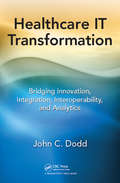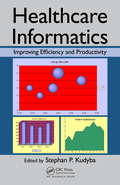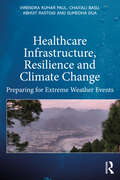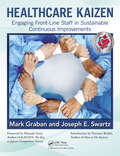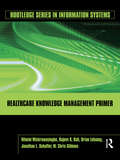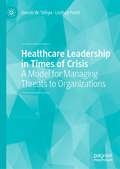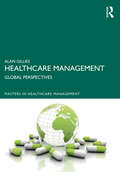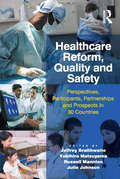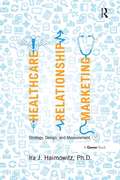- Table View
- List View
Healthcare Fraud
by Rebecca S. BuschAn invaluable tool equipping healthcare professionals, auditors, and investigators to detect every kind of healthcare fraudAccording to private and public estimates, billions of dollars are lost per hour to healthcare waste, fraud, and abuse. A must-have reference for auditors, fraud investigators, and healthcare managers, Healthcare Fraud, Second Edition provides tips and techniques to help you spot--and prevent--the "red flags" of fraudulent activity within your organization. Eminently readable, it is your "go-to" resource, equipping you with the necessary skills to look for and deal with potential fraudulent situations.Includes new chapters on primary healthcare, secondary healthcare, information/data management and privacy, damages/risk management, and transparencyOffers comprehensive guidance on auditing and fraud detection for healthcare providers and company healthcare plansExamines the necessary background that internal auditors should have when auditing healthcare activitiesManaging the risks in healthcare fraud requires an understanding of how the healthcare system works and where the key risk areas are. With health records now all being converted to electronic form, the key risk areas and audit process are changing. Read Healthcare Fraud, Second Edition and get the valuable guidance you need to help combat this critical problem.
Healthcare Hazard Control and Safety Management
by James T. TweedyComprehensive in scope, this totally revamped edition of a bestseller is the ideal desk reference for anyone tasked with hazard control and safety management in the healthcare industry. Presented in an easy-to-read format, Healthcare Hazard Control and Safety Management, Third Edition examines hazard control and safety management as proactive funct
Healthcare IT Transformation: Bridging Innovation, Integration, Interoperability, and Analytics
by John C. DoddThis book gives examples from healthcare institutions that are using IT automation and innovation to drive change and provides guidance on the strategic direction of HIT over the next five years. Improving the delivery of healthcare through HIT is vital for both the economic success of healthcare organizations and the care of the patient, but most EMR systems do not have an integrated and architected approach. This book provides a detailed approach on how to leverage IT for transformation. It also shows how to build upon the experiences of other industries and helps foster innovation by providing a vision of where technology can be an enabler.
Healthcare Informatics: Improving Efficiency and Productivity
by Stephan P. KudybaHealthcare Informatics: Improving Efficiency and Productivity examines the complexities involved in managing resources in our healthcare system and explains how management theory and informatics applications can increase efficiencies in various functional areas of healthcare services. Delving into data and project management and advanced analytics,
Healthcare Informatics: Improving Efficiency through Technology, Analytics, and Management
by Stephan P. KudybaHealthcare Informatics: Improving Efficiency through Technology, Analytics, and Management supplies an understanding of the different types of healthcare service providers, corresponding information technologies, analytic methods, and data issues that play a vital role in transforming the healthcare industry. All of these elements are reshaping the various activities such as workflow and processes of hospitals, healthcare systems, ACOs, and patient analytics, including hot spotting, risk stratification, and treatment effectiveness.A follow-up to Healthcare Informatics: Improving Efficiency and Productivity, this latest book includes new content that examines the evolution of Big Data and how it is revolutionizing the healthcare industry. It presents strategies for achieving national goals for the meaningful use of health information technology and includes sound project management principles and case illustrations for technology roll-out, such as Computer Physician Order Entry (CPOE) for optimal utilization.The book describes how to enhance process efficiency by linking technologies, data, and analytics with strategic initiatives to achieve success. It explains how to leverage data resources with analytics to enhance decision support for care providers through in-depth descriptions of the array of analytic methods that are used to create actionable information, including Business Intelligence, Six Sigma, Data, and Text Mining.
Healthcare Informatics: Improving Efficiency through Technology, Analytics, and Management (2nd Edition)
by Stephan P. KudybaHealthcare Informatics: Improving Efficiency through Technology, Analytics, and Management supplies an understanding of the different types of healthcare service providers, corresponding information technologies, analytic methods, and data issues that play a vital role in transforming the healthcare industry. All of these elements are reshaping the various activities such as workflow and processes of hospitals, healthcare systems, ACOs, and patient analytics, including hot spotting, risk stratification, and treatment effectiveness.
Healthcare Informatics: Strategies for the Digital Era
by Stephan P. Kudyba"This book addresses how health apps, in-home measurement devices, telemedicine, data mining, and artificial intelligence and smart medical algorithms are all enabled by the transition to a digital health infrastructure…..it provides a comprehensive background with which to understand what is happening in healthcare informatics and why."—C. William Hanson, III, MD, Chief Medical Information Officer and Vice President, University of Pennsylvania Health System. "This book is dedicated to the frontline healthcare workers, who through their courage and honor to their profession, helped maintain a reliable service to the population at large, during a chaotic time. These individuals withstood fear and engaged massive uncertainty and risk to perform their duties of providing care to those in need at a time of crisis. May the world never forget the COVID-19 pandemic and the courage of our healthcare workers".—Stephan P. Kudyba, Author Healthcare Informatics: Evolving Strategies in the Digital Era focuses on the services, technologies, and processes that are evolving in the healthcare industry. It begins with an introduction to the factors that are driving the digital age as it relates to the healthcare sector and then covers strategic topics such as risk management, project management, and knowledge management that are essential for successful digital initiatives. It delves into facets of the digital economy and how healthcare is adapting to the geographic, demographic, and physical needs of the population and highlights the emergence and importance of apps and telehealth. It also provides a high-level approach to managing pandemics by applying the various elements of the digital ecosystem. The book covers such technologies as: Computerized physician order entry (CPOE) Clinical Information Systems Alerting systems and medical sensors Electronic healthcare records (EHRs) Mobile healthcare and telehealth. Apps Business Intelligence and Decision Support Analytics Digital outreach to the population Artificial Intelligence The book then closes the loop on the efficiency enhancing process with a focus on utilizing analytics for problem solving for a variety of healthcare processes including the pharmaceutical sector. Finally, the book ends with current and futuristic views on evolving applications of AI throughout the industry.
Healthcare Infrastructure, Resilience and Climate Change: Preparing for Extreme Weather Events
by Virendra Kumar Paul Abhijit Rastogi Sumedha Dua Chaitali BasuThis book highlights the vulnerability of healthcare buildings in the context of climate change-triggered extreme weather events (EWEs) and the case for mitigation. With a concise discussion on climate change and its consequences in the form of such events, a cost model and equations that register losses and help quantify them are then presented. The model can be used to estimate the significant potential loss that might occur during an EWE and help healthcare facilities prepare for them. The book analyses cases of major EWEs in India over the last two decades and collates the data available into various categories. Through this research the authors have developed a framework which assists healthcare facilities with a detailed calculation of value losses, both tangible and intangible. The framework can be used to assess the impacts on healthcare buildings in terms of disruption of services so that appropriate decisions related to the resilience in healthcare planning can be taken into consideration. Thus, the book is useful for directing planning and design processes aimed at continuity of service and building resilience to perform in the face of natural disaster and extreme weather. The purpose of this book is to prompt facilities planners and healthcare facilities to prepare to respond to EWEs through the planning and design process in a rational manner. Built infrastructure professionals such as architects and engineers, policy makers, and academics with an interest in disasters, risk and climate change will all find this book to be key reading.
Healthcare Innovation Success: Learning from Organisational Experience
by Penny KechagioglouThe role of leadership in driving innovation through its different stages is fully explored in this book to enable clinical leaders and managers to design innovation frameworks. The book highlights how to maximize the benefits of innovation for organizations and integrated care systems while acknowledging that the process of innovation within healthcare organizations can be complex and needs to be well orchestrated to enable innovation to spread and sustain. The book examines the leadership enablers in healthcare innovation highlighting a new and refreshing strategic model of innovation. The model is used as the foundation to support the process of innovation, from ideation to implementation, within contemporary and ambitious healthcare organizations.
Healthcare Kaizen: Engaging Front-Line Staff in Sustainable Continuous Improvements
by Mark Graban Joseph E. SwartzHealthcare Kaizen focuses on the principles and methods of daily continuous improvement, or Kaizen, for healthcare professionals and organizations. Kaizen is a Japanese word that means "change for the better," as popularized by Masaaki Imai in his 1986 book Kaizen: The Key to Japan‘s Competitive Success and through the books of Norman Bodek, both of whom contributed introductory material for this book.Winner of a 2013 Shingo Research and Professional Publication Award!In 1989, Dr. Donald M. Berwick, founder of the Institute for Healthcare Improvement and former administrator of the Centers for Medicare & Medicaid Services, endorsed the principles of Kaizen in the New England Journal of Medicine, describing it as "the continuous search for opportunities for all processes to get better." This book shows how to make this goal a reality.Healthcare Kaizen shares some of the methods used by numerous hospitals around the world, including Franciscan St. Francis Health, where co-author Joe Swartz has led these efforts. Most importantly, the book covers the management mindsets and philosophies required to make Kaizen work effectively in a hospital department or as an organization-wide program.All of the examples in the book were shared by leading healthcare organizations, with over 200 full-color pictures and visual illustrations of Kaizen-based improvements that were initiated by nurses, physicians, housekeepers, senior executives and other staff members at all levels.Healthcare Kaizen will be helpful for organizations that have embraced weeklong improvement events, but now want to follow the lead of ThedaCare, Virginia Mason Medical Center, and others who have moved beyond just doing events into a more complete management system based on Lean or the Toyota Production System.
Healthcare Knowledge Management Primer (Routledge Series in Information Systems)
by Nilmini Wickramasinghe Rajeev K. Bali Brian Lehaney Jonathan Schaffer M. Chris GibbonsQuality care of patients requires evaluating large amounts of data at the right time and place and in the correct context. With the advent of electronic health records, data warehouses now provide information at the point of care and facilitate a continuous learning environment in which lessons learned can provide updates to clinical, administrative, and financial processes. Given the advancement of the information tools and techniques of today’s knowledge economy, utilizing these resources are imperative for effective healthcare. Thus, the principles of Knowledge Management (KM) are now essential for quality healthcare management. The Healthcare Knowledge Management Primer explores and explains essential KM principles in healthcare settings in an introductory and easy to understand fashion. This concise book is ideal for both students and professionals who need to learn more about key aspects of the KM field as it pertains to effecting superior healthcare delivery. It provides readers with an understanding of approaches to KM by examining the purpose and nature of its key components and demystifies the KM field by explaining in an accessible manner the key concepts of KM tools, strategies and techniques, and their benefits to contemporary healthcare organizations.
Healthcare Leadership in Times of Crisis: A Model for Managing Threats to Organizations
by Dennis W. Tafoya Lindsey PoethThis book addresses the challenges that healthcare organizations experience when attempting to manage the emergence of troublesome events or crises. It illustrates how experiences gained from event and crisis containment efforts can better prepare these organizations to prevent and/or manage other crises they may experience. Using a model outlining the relationship between a mismanaged event and the triggering of a crisis, the author defines the role of the leadership in healthcare organizations when developing, launching, and managing plans and programs to deal with these dangerous challenges brought on by crises, catastrophes, and disasters to their stakeholder networks. Readers with expertise in leadership and crisis management in general and healthcare management specifically will find this text useful in linking leadership expectations and competencies to event and crisis containment efforts.
Healthcare Made Easy: Answers to All of Your Healthcare Questions under the Affordable Care Act
by Michelle KatzAn easy-to-understand guide to the Affordable Care Act!Written by ABC World News' Real Money expert and healthcare advocate Michelle Katz, Healthcare Made Easy is the ultimate resource for understanding and navigating the Affordable Care Act. Using simple and easy-to-follow language, she answers important questions about the ACA, such as:Are there any exemptions to buying insurance under the Affordable Care Act?What is the new "80/20 Rule"? And what exactly is the Early Retiree Reinsurance Program?What does the ACA mean for small businesses? What benefits must you offer and what are the tax breaks?What is covered for your children under the new CHIP laws?How can you get pharmaceutical companies to lower your prescription costs? With the expert advice in Healthcare Made Easy, you will learn how to get the most out of your healthcare plan without having to sacrifice your needs or empty your pockets."Here is a guide, a map through the maze of healthcare decisions facing us all. Michelle has helped a lot of families. She is a champion of the consumer. A truly informed advocate." --Diane Sawyer"Michelle breaks down complicated laws and insurance regulations to make them understandable to everyone. She provides you with a road map to getting the best healthcare at the most affordable prices." --Tavis Smiley, Author, Television and Radio Host
Healthcare Management Control: A Research Overview (State of the Art in Business Research)
by Matthias Beck Michelle CarrThe COVID-19 pandemic has created unprecedented challenges to those responsible for the management of healthcare activities. These challenges require decision makers at all levels to possess a broad and comprehensive understanding of healthcare management tools, and especially of the interaction between formal control systems and the informal power dynamics which operate within healthcare organisations. Managing in healthcare is not only difficult because of the sector’s high-stakes ethical contexts but also because the health care workforce is inherently complex and heterogeneous. It is the purpose of this book to survey the expanding literature on management control in healthcare with the aim of giving readers a better understanding of the options available to managers, decision-makers and also educated observers of this important sector. This book summarises key debates and findings in this rapidly developing and increasingly important field. It explores state-of-the-art models and approaches, highlights unexplored questions and gives an outlook on novel and developing trends. In so doing it provides a hands-on-guide for aspiring healthcare managers and practitioner and offers critical insights into the more advanced academic literature for those seeking a thorough grounding in the accounting and finance aspects of healthcare management.
Healthcare Management Engineering In Action: Applying Fundamental Management Principles for Operational Decision Making in Healthcare (Business Guides on the Go)
by Alexander KolkerThe updated 2nd edition of Healthcare Management Engineering In Action in the Business Guides on the Go series provides a comprehensive exploration of healthcare management operations. Through a systematic comparison of predictive and analytic decision-making methodologies with traditional management approaches, the book employs case studies derived from real-world hospital and clinic scenarios. It addresses a spectrum of problem encompassing patient flow, capacity management, resource allocation, staffing and scheduling, statistical data analytics, and cost distribution among cooperating providers.The revised edition contains enhanced content, spotlighting key management principles vital for effective operational decision-making. The book encompasses a wide array of quantitative methods, including discrete event simulation, queuing analytic theory, linear, integer and probabilistic optimization, among others. By acting as a bridge between management engineering experts and healthcare administrators, Healthcare Management Engineering is an invaluable resource for hospital and clinic leadership, aiding them in their managerial roles. Furthermore, it serves as a comprehensive repository of introductory challenges and projects suitable for graduate-level students in healthcare management and administration.
Healthcare Management Engineering: What Does This Fancy Term Really Mean?
by Alexander KolkerThis Briefs Series book illustrates in depth a concept of healthcare management engineering and its domain for hospital and clinic operations. Predictive and analytic decision-making power of management engineering methodology is systematically compared to traditional management reasoning by applying both side by side to analyze 26 concrete operational management problems adapted from hospital and clinic practice. The problem types include: clinic, bed and operating rooms capacity; patient flow; staffing and scheduling; resource allocation and optimization; forecasting of patient volumes and seasonal variability; business intelligence and data mining; and game theory application for allocating cost savings between cooperating providers. Detailed examples of applications are provided for quantitative methods such as discrete event simulation, queuing analytic theory, linear and probabilistic optimization, forecasting of a time series, principal component decomposition of a data set and cluster analysis, and the Shapley value for fair gain sharing between cooperating participants. A summary of some fundamental management engineering principles is provided. The goal of the book is to help to bridge the gap in mutual understanding and communication between management engineering professionals and hospital and clinic administrators. The book is intended primarily for hospital/clinic leadership who are in charge of making managerial decisions. This book can also serve as a compendium of introductory problems/projects for graduate students in Healthcare Management and Administration, as well as for MBA programs with an emphasis in Healthcare.
Healthcare Management: Global Perspectives (Masters in Healthcare Management)
by Alan GilliesHealthcare Management takes a look at international perspectives in healthcare management and the way regional priorities, national income, and social factors are crucial to effective healthcare services. Readers are provided the skills to address issues and solve problems as a healthcare manager by understanding and appreciating the complex interrelationships of global health provision. The book compares and contrasts different healthcare systems, examining the role of policymaking, health financing, healthcare beyond hospitals, leadership, risk management, and quality. A range of international case studies provide the opportunity to see how different theories work in practice. This comprehensive book is suitable for students and professionals undertaking healthcare management courses.
Healthcare Management: Managed Care Organisations and Instruments (Springer Texts in Business and Economics)
by Volker Eric AmelungThis textbook on Healthcare Management provides a systematic and comprehensive overview of the organisational forms and management instruments implemented in managed care.Within the international discussion on the structure of healthcare systems, managed care is an increasingly important topic. Over more than twenty years managed care approaches have fundamentally influenced healthcare systems in terms of patient orientation, efficiency, and quality. Experts assume that up to 20% of healthcare expenses can be saved by applying high-quality managed care approaches. By using suitable organisational forms and management principles, not only can costs be reduced, but the quality of medical service provision can be augmented. Managed care is therefore much more than a cost-cutting strategy. Advocates consider managed care to be a logical and necessary developmental step in modern healthcare systems. An increase in quality and at the same time a reduction of costs is not seen as contradictory but rather as consistent. Therefore, managed care is a response to changed challenges in the provision of healthcare.
Healthcare Management: Managed Care Organisations and Instruments (Springer Texts in Business and Economics)
by Volker Eric AmelungWithin the international discussion on the structure of healthcare systems, managed care is an increasingly important topic. Over more than twenty years managed care approaches have fundamentally influenced healthcare systems in terms of patient orientation, efficiency, and quality. Experts assume that up to 20% of healthcare expenses can be saved by applying high-quality managed care approaches. By using suitable organisational forms and management principles, not only can costs be reduced, but the quality of medical service provision can be augmented. Managed care is therefore much more than a cost-cutting strategy. The goal of this book is to offer a systematic overview of the organisational forms and management instruments implemented in managed care. Advocates consider managed care to be a logical and necessary developmental step in modern healthcare systems. An increase in quality and at the same time a reduction of costs is not seen as contradictory but rather as consistent. Therefore, managed care is a response to changed challenges in the provision of healthcare.
Healthcare Operations Management: A Holistic Care Chain Perspective (SpringerBriefs in Service Science)
by Qiang SuAddressing the entire care chain, this book presents the outcomes of advanced research on healthcare operations management based on real-world data and practices in China. It includes hands-on methods and applications in this interdisciplinary research field, which combines healthcare service, operations management, industrial engineering and information technology.The content is divided into three parts, reflecting the entire care chain. The first part discusses the pre-hospital service stage and explores resource deployment problems in emergency medical service, such as ambulance allocation. The second part focuses on inpatient care services, including staffing and task allocation among nurses and doctors based on multi-project management under uncertainties. In addition, a highly promising diagnosis approach is proposed and a specific algorithm is derived on the basis of real-world datasets which can improve the diagnosis accuracy remarkably. In turn, the third part considers the post-hospital service stage, which most often takes place at community hospitals, and provides a quantitative evaluation and optimization of scheduling for tasks and team members for home care services.The book is intended for a broad audience, including students, researchers and practitioners working in various areas of healthcare management, service management, and operations management.
Healthcare Payment Systems: An Introduction
by Duane C. AbbeyHealthcare Payment Systems: An Introduction provides a complete introduction to healthcare payment systems. Written by Duane Abbey, one of the nation‘s leading experts and most sought out consultants on payment systems, this volume makes the monumental task of medical reimbursement approachable and manageable. Covering the fundamentals and terminology needed to understand this discipline, and the strategies needed to master it, Dr. Abbey will help you begin to develop the solid core of skills and knowledge needed to confidently approach payment systems as tools to use rather than hazards to avoid -- tools that will lead to improved revenue cycles and higher levels of profitability.
Healthcare Payment Systems: Fee Schedule Payment Systems
by Duane C. AbbeyFor healthcare providers and patients alike, the ways of private third-party payer payment systems can be mysterious and oftentimes quite frustrating. Payment for hospital, nursing, or homecare services can be subject to a variety of payment systems including cost-based and charge-based or those with payments that are determined in advance. Knowing
Healthcare Policy, Innovation and Digitalization: Contemporary Strategy and Approaches (Accounting, Finance, Sustainability, Governance & Fraud: Theory and Application)
by Eyüp Çetin Hilal ÖzenThis book takes a deep look at healthcare in today’s post-pandemic world. It combines both theory and application to reflect a new era for healthcare. The need for innovation, digitalization, and enhanced policies in healthcare has never been greater than it is today. Taking this need into consideration, this book offers a multidisciplinary approach to healthcare, in both managerial and clinical views. Since the book combines both qualitative and quantitative studies about healthcare, readers will receive a broad view of healthcare issues and policies in today’s world.
Healthcare Reform, Quality and Safety: Perspectives, Participants, Partnerships and Prospects in 30 Countries
by Julie Johnson Jeffrey Braithwaite Yukihiro MatsuyamaThis book offers a global perspective on healthcare reform and its relationship with efforts to improve quality and safety. It looks at the ways reforms have developed in 30 countries, and specifically the impact national reform initiatives have had on the quality and safety of care. It explores how reforms drive quality and safety improvement, and equally how they act to negate such goals. Every country included in this book is involved in a reform and improvement process, but each takes place in a particular social, cultural, economic and developmental context, leading to differing emphases and varied progress. Methods for tackling common problems - financing, efficiencies, effectiveness, evidence-based practice, institutional reforms, quality improvement, and patient safety initiatives - also differ. Representatives from each nation provide a chapter to convey their own situation. The editors draw a conclusion from these numerous contributions and synthesize the themes emerging into a coherent ’lessons learned’ summary that delivers value to the numerous stakeholders. Healthcare Reform, Quality and Safety forms a compendium of the current ’state of the art’ in global healthcare reform. This is the first book of its type, and offers a unique opportunity for cross-fertilization of ideas to the mutual benefit of countries involved in the project. The content will be of interest to governments, policymakers, managers and leaders, clinicians, teaching academics, researchers and students.
Healthcare Relationship Marketing: Strategy, Design and Measurement
by Ira J. HaimowitzIn recent years there have been dramatic changes in the pharmaceutical promotional landscape, affecting both consumers and healthcare professionals. One consequence of these dynamics is the need for pharmaceutical companies to plan new kinds of dialogue and relationships with their stakeholders. The evolution has been from mass-channel "push" marketing to two-way, multi-channel relationship marketing. Targeted Emails, webinars, mobile messages, and social networks are expanding in usage. This book is a practical overview and resource guide for the design and measurement of pharmaceutical relationship marketing (RM) programs. There are descriptions of each aspect of pharmaceutical RM design and measurement, including a running case study with follow-up exercises. The author has also conducted interviews from several pharmaceutical marketing industry experts, each having 15 years or more of working healthcare RM knowledge, and each speaking on their specific specialities. For newcomers to healthcare marketing, this book can serve as a foundation and introduction that provides framework, details, and examples of both relationship marketing designs and associated measurement disciplines. Healthcare Relationship Marketing will also be valuable to readers currently working in pharmaceutical marketing or sales who may not have exposure to the particular disciplines of relationship marketing and direct response measurement and optimization. Even for the experienced practitioner this will serve as a convenient reference that pulls together all of the program components and measurement frameworks within a single book. This book may also serve as a textbook within a university course in marketing, or a pharmaceutical business program.


